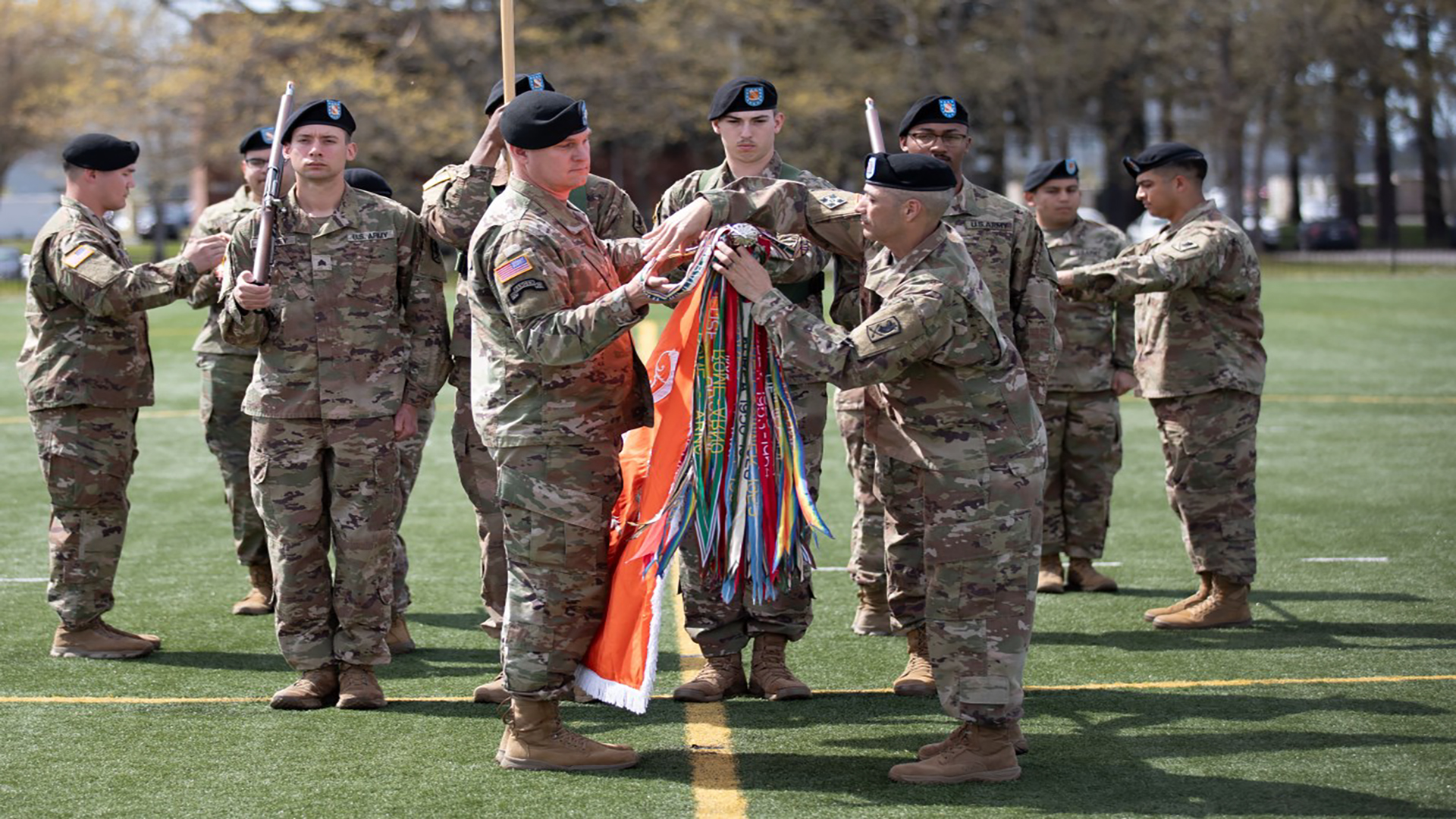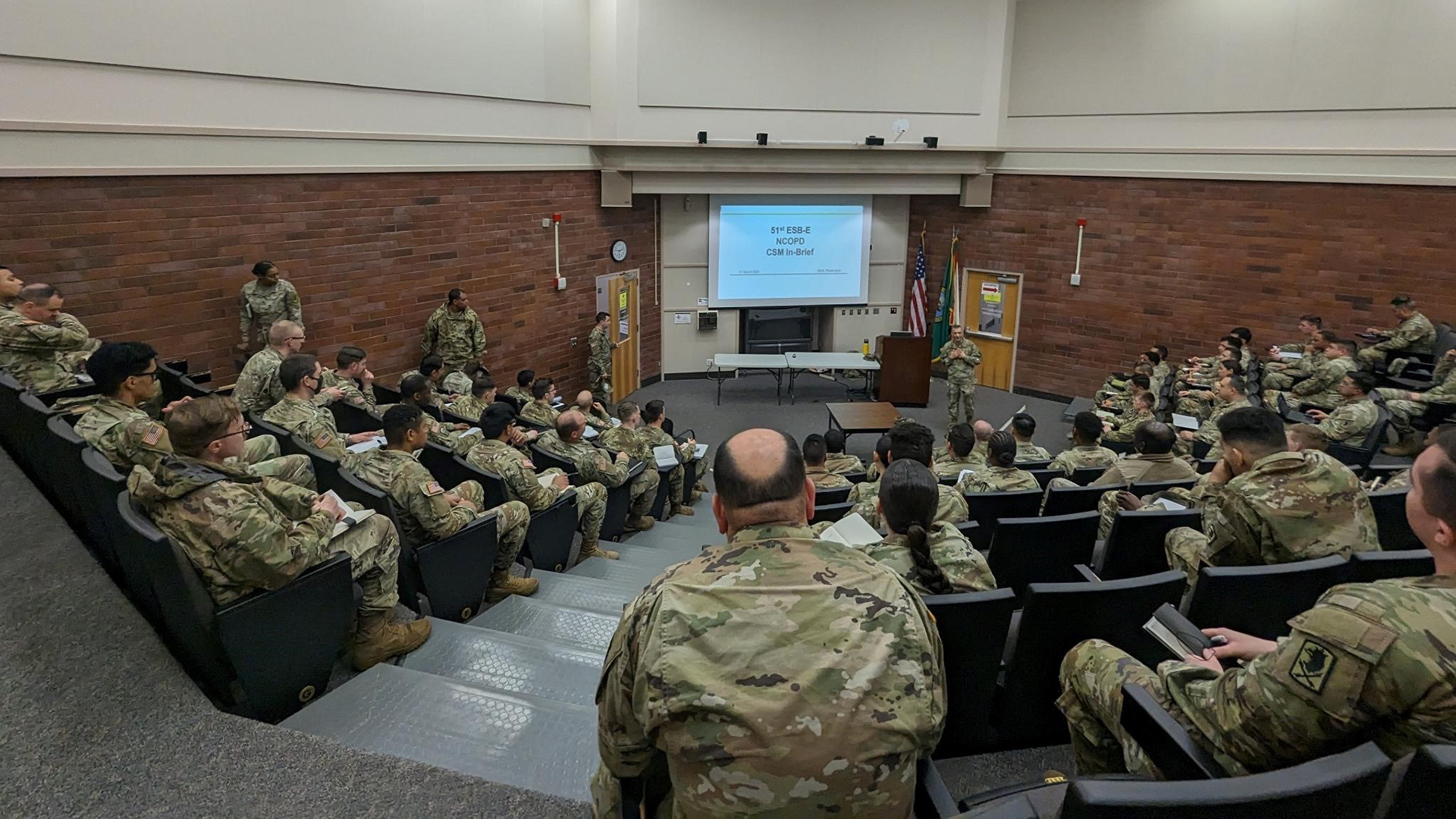A Focus on Investing in Leader Development
The Army’s strength
By Command Sgt. Maj. Billy J. Atkinson 51st Expeditionary Signal Battalion-Enhanced
Article published on: September 1, 2024 in the Army Communicator Fall/Winter 2024 Edition
Read Time: < 4 mins

Lt. Col. Nicolas Beck and Command Sgt. Maj. Billy J. Atkinson, 51st ESB-E, case the colors at Joint Base Lewis-McChord, Washington, prior to deploying. (Photo by I Corps Public Affairs Office)
It is no secret that people are the Army’s greatest asset. Operating advanced and challenging equipment in peacetime and wartime environments requires the attention and participation of professional, skilled, and trained leaders. When Soldiers lack leadership traits such as intelligence, awareness, problem-solving, decision-making, and communication, which are gained through leadership development, they increase the risk of vulnerabilities. Therefore, leadership development should always be a priority in every leader’s mind.
According to the Department of the Army (2013), “leader development is a deliberate, continuous, sequential, and progressive process that grows Soldiers into competent and confident leaders.” Developing competent and confident leaders takes time and effort and must remain a priority. Investing in leader development will equip the Army with a capability no other adversary can overcome.
Make it a Priority
Many leaders do not make leadership development a priority within their organization. According to a recently completed study, an area of weakness in the Army is the investment and prioritization of developing leaders (Center for the Army Profession and Leadership Annual Study of Army Leadership [CASAL], 2022). The lack of investment can be for many reasons, but one primary reason is the organization’s operational tempo (OPTEMPO).
Senior leaders often remove scheduled leadership development activities or events from calendars due to higher priority requirements. CASAL (2022) provides statistical evidence by reporting that only 37% of active component leaders report their units making leader development a priority, and even more concerning was only 31% reported a formal plan or published guidance for leader development. Senior leaders removing such events from calendars and the CASAL (2022) report is evidence that leadership development is viewed as something other than an Army priority or urgency. This investment will benefit the organization and have a more significant advantage for the Army and the individual Soldiers. Leaders can prioritize, invest, and integrate development within their organizations by investing time and effort in creating and tailoring programs that fit individual units.
One Battalion
Leader development is a proactive process aimed at filling knowledge gaps and building competent and effective leaders (DA, 2024). The 51st Expeditionary Signal Battalion-Enhanced (ESB-E) builds competent and effective leaders by implementing the battalion NCO development strategy. While currently deployed to the U.S. Central Command (CENTCOM) area of responsibility (AOR), the 51st ESB-E established a consistent, reoccurring, and structured program focused on different levels of leadership development. The program started with a published memorandum of instruction to communicate the importance of leadership development. This memorandum provided the means, ways, and ends of the battalion NCO development program. The program includes several areas of focus.
Currently, the senior leaders of 51st ESB-E are developing a leadership academy scheduled for completion by the first quarter of fiscal year 2025. Several leaders in the battalion are participating in the creation, structure, and design of the leadership development program and are utilizing the opportunity for additional leadership development. Additionally, the battalion started a battalion Sergeant Audie Murphy Club (SAMC) study group, which attracted other leaders from external units to join, extending influence outside the organization. The goal is to get some well-deserved leaders inducted into the prestigious SAMC. Furthermore, brown bag lunches, or “knowledge-sharing sessions,” occur three times a month; each focused on a specific leadership level. The intent of these sessions is for the battalion command sergeant major (CSM) to select a monthly article from the NCO Journal or another publication platform, which then becomes the topic of discussion for each session. This provides an opportunity to share the products other leaders published, which aligns with stewarding the Army profession. This program intends to create opportunities and build confidence for leaders to publish personalized professional articles. To support the Chief of Staff of the Army, Gen. Randy George’s Harding Project initiative, the battalion has challenged its leaders to write and share their experiences within the CENTCOM AOR. In the next few months, the battalion will share articles through different platforms, such as the NCO Journal and the Army Communicator. Additionally, leaders are challenged to share any other experiences to steward the Army profession.

Command Sgt. Maj. Billy J. Atkinson, 51st ESB-E, conducts battalion NCO professional development at Joint Base Lewis-McChord, Washington. (Photo by 1st Sgt. Randy Cavazos, 51st ESB-E)
Another program implemented within the battalion is the CSM’s reading program. The intent here is the battalion CSM selects one book title every quarter and distributes four to five copies throughout the quarter. Leaders are then challenged to read the book, and upon completion, pass the book to another individual in the battalion. The goal is to continue this process for eternity. Readers are instructed to write their names on the inside cover before passing the book. Currently, the battalion has distributed 13 books, consisting of three different book titles. The battalion also conducts monthly brigade, battalion, and company-level NCO professional development sessions. Topics are intended to close leadership gaps within the NCO Corps at each level. All this occurs in an OPTEMPO decentralized environment with teams spread across eight countries and over 25 locations. The 51st ESB-E focused on leader development in a deployed environment by using opportunities to build knowledge and skills with our No. 1 asset: our people.
Conmclusion
These are just a few initiatives and ideas that one battalion is taking to invest in developing Army leaders and making it one of the priorities. If every battalion makes development a priority, the Army will quickly close every knowledge gap that may currently exist within the NCO Corps, ensuring subsequent victory. Whether integrating leader professional development sessions, leadership academies, SAMC preparation, reading and writing programs, or knowledge-sharing sessions, senior leaders must invest in developing people today and every day.
References